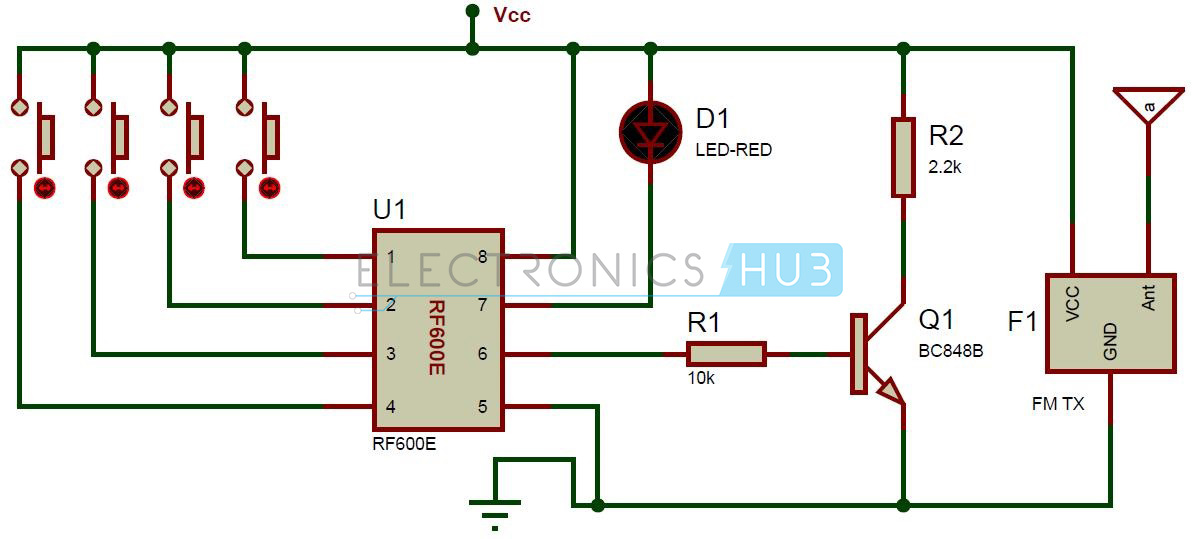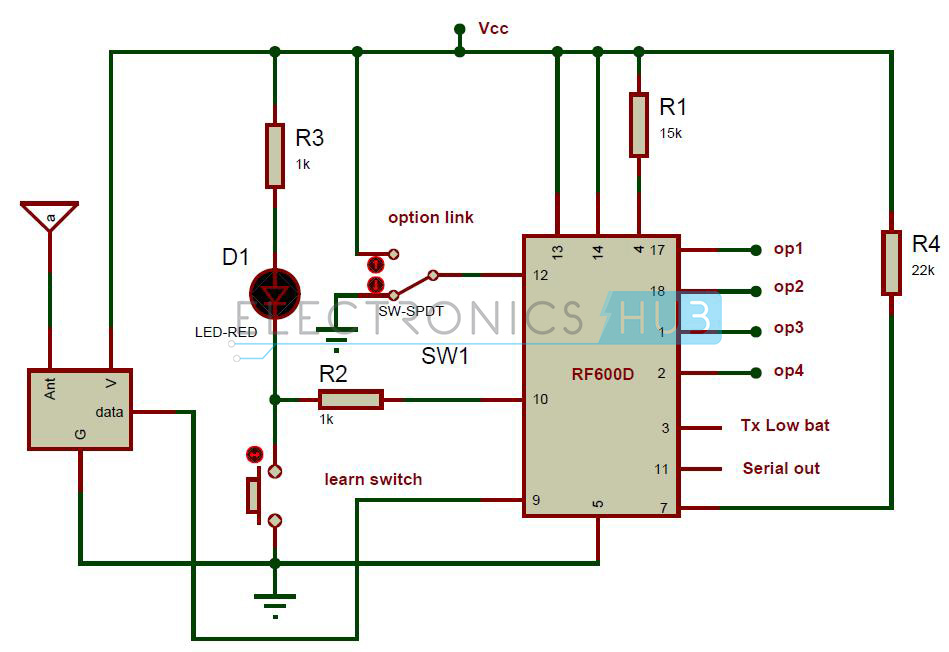This system uses FM (Frequency Modulation) for transmission. If you press any push button then corresponding code is generated at transmission section. Here encoder is used to convert parallel data to serial. This serial data is given to the FM Tx module to transmit. FM Rx module receives this serial data and fed to the decoder to produce the corresponding output.
FM Remote Encoder and Decoder Circuit Diagram:
Transmitter Section:
Circuit Components:
RF600E encoder FM Transmitter module 4 push buttons Bc848 Transistor Led Resistors – 2.2k, 10k
Receiver Section:
Circuit Components:
RF600D Decoder FM Receiver module Slide switch Push button Red LED Resistors – 1k(2), 15k, 22k
FM Remote Encoder/Decoder Circuit Design:
The circuit mainly consists of two sections, one is Transmitter section used t transmit the remote data and other is Receiver section used to receive the data.
This section consists of RF600E encoder, FM transmitter module, four switches and LED. Four push buttons are used to generate the parallel data. If you press any push button, then corresponding code is generated at the 6th pin of encoder. Here the LED which is connected to the 7th pin of encoder is used for indicating the signal transmission.
RF600E Encoder:
This pair of encoder and decoder ICs uses balanced Manchestar encoded data protocol for transmission. This encoder IC requires just fewer components to use it as a transmitter. The transmission is automatic there is no need of human intervention.
The data format includes a pre-amble, header, encrypted data followed by CRC bit. Here the packet size is 67 bits.
Low Battery Indication:
This encoder IC reads the battery status for each operation. If the voltage is below 3.8 volts then flag bit is transmitted to the decoder IC.
Pin Configuration:
Pin No.NameDescription 1S0Input data pin0 2S1Input data pin1 3S2Input data pin2 4S3Input data pin3 5VssGround reference connection 6OPData output pin 7LEDCathode connection for driving LED during the transmission 8VccSupply voltage pin
The receiver section consists of RF600D decoder and its associated components. Pins 17, 18, 1 and 2 are the digital output pins corresponding to the input switches. If you press any push button, then the corresponding pin at decoder becomes low. Here SPDT switch is used to select latching or memory digital function. The learn switch is used to enter the decoder IC into the “learn mode”.
RF600D Decoder:
In this RF chipset, protocol data is sent serially as a stream of ASCII characters with a baud rate of 9600 bits per second. While coming to the frame format 8 data bits with one stop bit.
Pin Configuration:
Pin No.NameInput/OutputDescription 1OP3OutData output pin 2OP4OutData output pin 3LBOutPin goes low, when battery is low 4VccInSupply voltage pin 5VssInGround pin 6ECSOutConnected to EEPROM CS pin 7ECLKOutConnected to EEPROM CLK pin 8EDATI/0connected to EEPROM DATA PIN 9INInData input 10LRNInlearn/erase switch and status LED drive 11SD1Outserial data output 12LKINInOption Link Input for Momentary or Latched outputs 13SLEEPIn1 = Run, 0 = Sleep Mode 14VccInPositive supply voltage pin 15UnusedN/Ano connection 16UnusedN/Ano connection 17OP1OutData output pin 18OP2OutData output pin
How to Operate FM Remote Encoder and Decoder Circuit?
FM Remote Encoder/Decoder Circuit Advantages:
FM Remote Encoder/Decoder Circuit Applications:
Used in general purpose Remote control applications Used in burglar alarm systems used in automotive systems Used in Electronic door locks
This circuit is theoretical and may require some practical changes.
Comment * Name * Email * Website
Δ







![]()